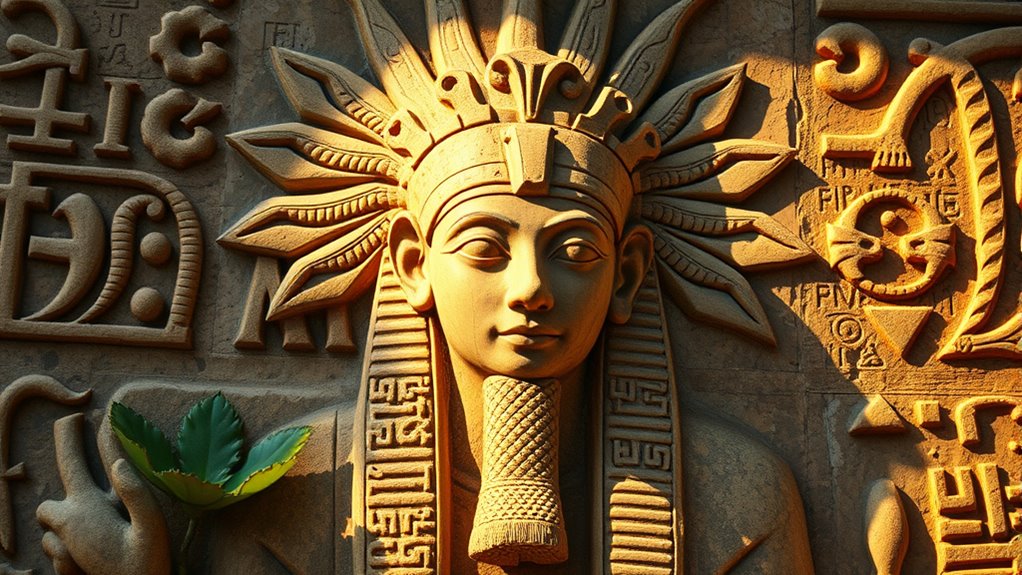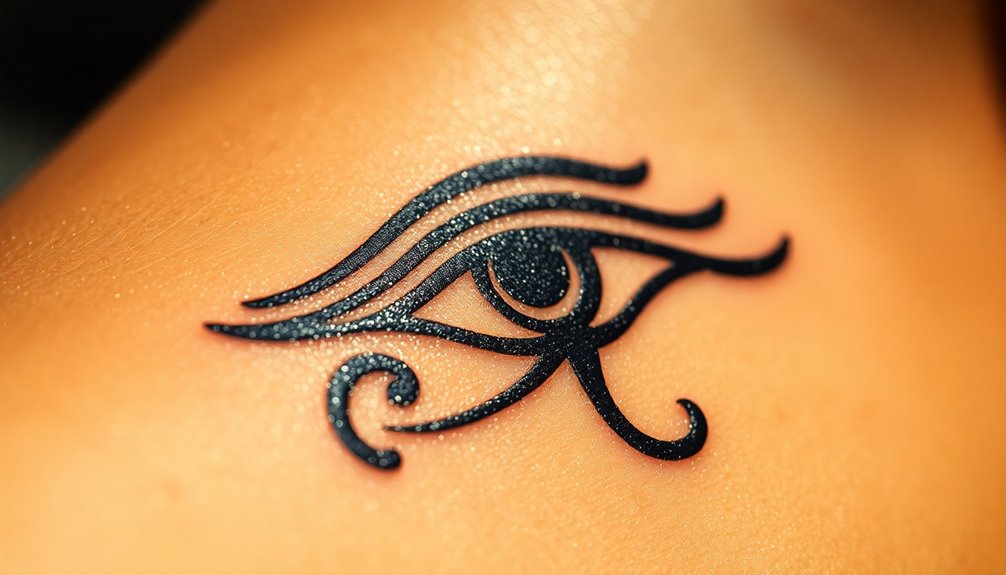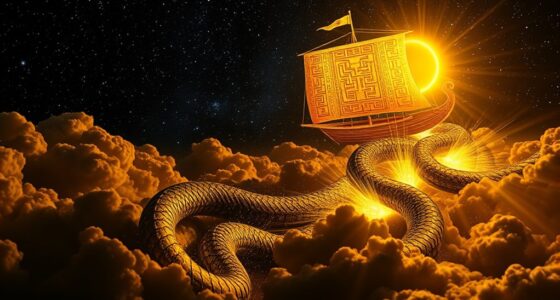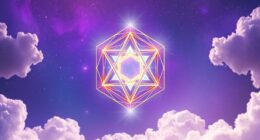The Osiris myth cycle is a compelling story of death, resurrection, and eternal life that has influenced many religions. It features Osiris’s journey from ruler of the underworld to symbol of rebirth, helped by his wife Isis and son Horus. Symbols like the ankh and scarab embody renewal and divine authority. This myth shaped funeral rites, ideas of divine kingship, and inspired beliefs in resurrection across cultures. If you continue exploring, you’ll uncover how this ancient story still impacts spiritual ideas today.
Key Takeaways
- The Osiris myth symbolizes death, rebirth, and eternal life, inspiring beliefs in resurrection across multiple religions.
- Osiris’s resurrection by Isis established themes of divine renewal and divine authority influencing later spiritual traditions.
- Symbols like the ankh and scarab, rooted in the myth, represent life, rebirth, and protection, shaping religious iconography.
- The myth influenced Egyptian funerary practices, emphasizing rebirth and eternal life, and inspired similar concepts in Greek and Christian thought.
- Its enduring themes of mortality and divine resurrection continue to inspire spiritual beliefs and religious doctrines today.

The Osiris Myth Cycle is a central story in ancient Egyptian religion that explains the themes of death, rebirth, and eternal life. As you explore this myth, you’ll notice how Egyptian symbolism plays a vital role in conveying complex spiritual ideas. The story of Osiris, Isis, and Horus is not just a tale but a reflection of how the Egyptians viewed the cycle of life and death. Symbols like the crook and flail, the ankh, and the lotus are imbued with meaning, representing authority, life, and renewal. These symbols aren’t just decorative; they serve as visual cues that reinforce the myth’s deeper spiritual messages. The mythological influence of Osiris extends beyond Egypt, shaping religious ideas and rituals across the ancient world. Its themes of resurrection and divine kingship influenced later traditions, including Greek and Christian thought. When you study Egyptian mythology, you’ll see how the story of Osiris became a blueprint for understanding eternal life, inspiring rituals like mummification and funerary practices designed to guarantee rebirth in the afterlife.
In the myth, Osiris is often depicted as the ruler of the underworld, embodying the concept of death and resurrection. His death at the hands of his brother Seth symbolizes chaos and destruction, but his subsequent resurrection by his wife Isis signifies hope and renewal. The myth’s influence is evident in how the Egyptians used specific symbols to represent these ideas. The scarab beetle, for example, became a powerful symbol of rebirth, echoing the myth’s themes of renewal after death. As you examine Egyptian artifacts, you’ll see these symbols frequently integrated into tomb carvings and amulets, serving both protective and spiritual functions. The myth also underscores the importance of divine authority, with Osiris’s rulership over the afterlife emphasizing the divine right to govern both earthly and spiritual realms. This mythological influence extended well beyond Egypt, inspiring ideas of divine kingship in other cultures and shaping religious doctrines that emphasize resurrection and eternal life. Additionally, the study of ancient mythology reveals how these stories served as foundational narratives that reinforced social and spiritual hierarchies.
Ultimately, the Osiris Myth Cycle remains a foundational story that has shaped spiritual thought for millennia. Its rich symbolism and mythological influence continue to resonate, offering insights into how ancient Egyptians understood mortality and the promise of rebirth. As you explore this myth, you’ll see how it’s more than just a story—it’s a spiritual blueprint that has influenced countless religious traditions, emphasizing that death is not the end but a gateway to eternal life. The enduring power of the Osiris myth lies in its ability to inspire hope and reinforce the idea that life persists beyond death through divine resurrection and renewal.
Frequently Asked Questions
How Does Osiris’S Myth Influence Modern Spiritual Beliefs?
The current question explores how myths shape beliefs today. You might see spiritual symbolism in stories like Osiris’s resurrection, which influence modern religion and spirituality. His myth influence emphasizes themes of rebirth, renewal, and hope, resonating with many seeking meaning beyond the material world. By understanding these stories, you deepen your connection to universal ideas of life, death, and rebirth, enriching your spiritual journey and expanding your perspective on life’s mysteries.
Are There Similar Resurrection Myths in Other Ancient Cultures?
In exploring your question, you see that comparative mythology reveals cultural parallels in resurrection myths across ancient civilizations. For example, you find similar stories in Mesopotamian, Greek, and Indian traditions, where gods or heroes die and return to life. These myths reflect shared themes of renewal and hope, showing how different cultures express universal ideas about life, death, and rebirth through their unique religious stories and symbols.
What Symbols Are Associated With Osiris’S Resurrection Story?
Imagine the shimmering scarab beetle, a symbol of rebirth, rolling a sacred sun disk across the sky. In Osiris’s resurrection story, symbols like the crook and flail represent kingship and protection, while sacred amulets and funeral rituals embody renewal. These symbols serve as powerful reminders of rebirth, guiding souls through the afterlife and reinforcing the eternal cycle of death and renewal in ancient Egyptian belief.
How Did the Osiris Myth Evolve Over Egyptian History?
You see, the Osiris myth evolved through mythological variations and historical shifts over Egyptian history. As time passed, different regions and rulers adapted the story to reflect changing beliefs and political powers. You might notice new symbols or themes emerging, emphasizing Osiris’s role as a god of rebirth and the afterlife. These adaptations helped keep the myth relevant, shaping Egyptian religion and culture for centuries.
What Lessons Does the Osiris Myth Teach About Death and Rebirth?
You learn that the myth teaches important moral lessons about death and rebirth, emphasizing the hope of life afterlife. It shows that even in death, there’s potential for renewal and transformation, inspiring you to see death not as an end but as part of a continuous cycle. This story encourages you to live morally, knowing that your actions influence your journey into the afterlife and your rebirth.
Conclusion
As you uncover the Osiris myth cycle, you realize it’s more than just an ancient story—it’s a foundation for hope and renewal. But what if its true power extends beyond history, shaping beliefs you’ve yet to explore? The secrets of Osiris could hold the key to understanding life, death, and rebirth. Are you ready to explore deeper and discover what mysteries still lie hidden beneath the surface? The journey’s just beginning.











